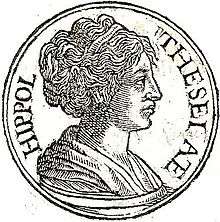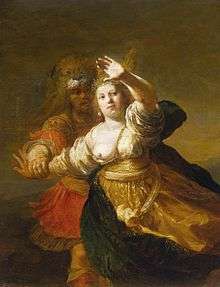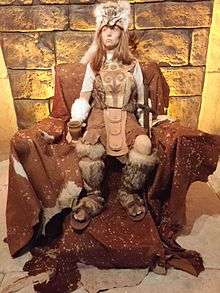Hippolyta


In Classical Greek mythology, Hippolyta (/hɪˈpɒlɪˌtə/; Greek: Ἱππολύτη Hippolyte) was the Amazonian queen who possessed a magical girdle she was given by her father Ares, the god of war. The girdle was a waist belt that signified her authority as queen of the Amazons. She figures prominently in the myths of both Heracles and Theseus. As such, the myths about her are varied enough that they may be about several different women.[1]
The Ninth Labour of Heracles
In the myth of Heracles, Hippolyta's girdle (ζωστὴρ Ἱππολύτης) was the object of his ninth labor. He was sent to retrieve it for Admeta, the daughter of King Eurystheus.[2][3][4][5][6][7][8] Most versions of the myth indicate that Hippolyta was so impressed with Heracles that she gave him the girdle without argument, perhaps while visiting him on his ship. Then (according to Pseudo-Apollodorus), the goddess Hera, making herself appear as one of the Amazons, spread a rumor among them that Heracles and his crew were abducting their queen, so the Amazons attacked the ship. In the fray that followed, Heracles slew Hippolyta, stripped her of the belt, fought off the attackers, and sailed away.
In the myth of Theseus, the hero joined Heracles in his expedition, or went on a separate expedition later, and was actually the one who had the encounter with Hippolyta. Some versions say he abducted her, some that Heracles did the abducting but gave her to Theseus as spoils, and others that she fell in love with Theseus and betrayed the Amazons by willingly leaving with him. In any case, she was taken to Athens where she was wed to Theseus, being the only Amazon to ever marry. In some renditions the other Amazons became enraged at the marriage and attacked Athens. This was the Attic War, in which they were defeated by Athenian forces under Theseus or Heracles. In other renditions Theseus later put Hippolyta aside to marry Phaedra. So Hippolyta rallied her Amazons to attack the wedding ceremony. When the defenders closed the doors on the attackers, either Hippolyta was killed, Theseus directly killed her in the fight, she was accidentally killed by another Amazon, Molpadia, while fighting by Theseus’ side, or was accidentally killed by her sister Penthesilea during this battle or in a separate incident. This killer was in turn slain by Theseus or Achilles. Some stories paint Theseus in a more favorable light, saying that Hippolyta was dead before he and Phaedra were wed, and this battle did not occur. Further complicating the narratives, a number of ancient writers say the Amazon in question was not Hippolyta at all, but her sister Antiope, Melanippe, or Glauce. Moreover, there are combined versions of the tale in which Heracles abducts and kills Hippolyta while Theseus (assisted by Sthenelus and Telamon) abducts and marries Antiope. There are also stories that Hippolyta or Antiope later bore Theseus a son, Hippolytus.[9][10][11][12][13][14][15][16]
Shakespeare character

In William Shakespeare's A Midsummer Night's Dream, Hippolyta is engaged to Theseus, the duke of Athens. In Act I, Scene 1 she and he discuss their fast-approaching wedding, which will take place under the new moon in four days (I.i.2). Theseus declares to Hippolyta that, although he "wooed her with his sword," he will wed her "with pomp, with triumph, and with revelling" and promises to begin a celebration that will continue until the wedding (I.i.19).
Although Hippolyta figures only marginally through the middle of the play, she resumes a strong role in Act V, scene I. There she and Theseus discuss some preceding events, namely the magical romantic confusions that the Athenian youths report from the night before. Theseus is skeptical about the veracity of their tale, but Hippolyta questions whether they would all have the same story if indeed, the night's adventures were imagined. She argues that the youths' agreement on the way the night's events unfolded proves that things occurred just as they say.
The fact that Hippolyta stands up to Theseus and disagrees with him here is significant. In Shakespeare's time it was common practice for a wife to be submissive, as expressed in The Taming of the Shrew. This play is unusual in its portrayal of strong women. Hippolyta, in particular, is strong, coming as she does from a tribe of fierce, empowered women of which she was the queen. In a feminist analysis, Louis Montrose contends: "Amazonian mythology seems symbolically to embody and to control a collective anxiety about the power of a female not only to dominate or reject the male but to create and destroy him."[17] Hippolyta attracts Theseus with her feminine allure and charm to such a degree, however, that he is completely smitten with her. Despite her forceful nature, then, she becomes the object of Theseus' passion. By marrying Hippolyta, Theseus is laying down his sword, "the weapon which gave him power and authority over her," and essentially surrendering. By the end of the play, Hippolyta has added to her power, becoming the queen of a new realm, Athens.
The character of Hippolyta also appears in The Two Noble Kinsmen, a play co-written by Shakespeare and John Fletcher.
Contemporary references
In Agatha Christie's novel "The Labours of Hercules", Hercule Poirot rescues a painting of Hippolyta giving her girdle to Hercules by Rubens.
In the DC Universe, this rendition of Hippolyta is the queen of Amazons who have sequestered themselves to an island (Themyscira, Paradise Island). She is also the mother of Princess Diana (aka Wonder Woman), which is the first time this mythological character has ever had a daughter.
References
- ↑ Robert Graves (1955) The Greek Myths
- ↑ Euripides, Hercules Furens, 408 sqq.
- ↑ Apollonius Rhodius, Argonautica, II. 777 sqq. and 966 sqq.
- ↑ Diodorus Siculus, Bibliotheca Historica, IV. 16
- ↑ Ps.-Apollodorus, Bibliotheke, II. 5. 9
- ↑ Pausanias, Hellados Periegesis, V. 10. 9
- ↑ Quintus Smyrnaeus, Posthomerica, VI. 240 sqq.
- ↑ Hyginus, Fabulae, 30
- ↑ Isocrates, Orations, XII. 193
- ↑ Diodorus Siculus, Bibliotheca Historica, II. 46. 5, IV. 28 and 64
- ↑ Ps.-Apollodorus, Bibliotheke, I. 16-17, V. 1-2
- ↑ Seneca, Hippolytus, 927 sqq.
- ↑ Plutarch, Theseus, 26-28
- ↑ Pausanias, Hellados Periegesis, I. 2. 1, I. 15. 2, I. 41. 7, II. 32. 9, V. 11. 4 and 7
- ↑ Quintus Smyrnaeus, Posthomerica, I. 18 sqq., 227 sqq., 538 sqq.
- ↑ Hyginus, Fabulae, 30
- ↑ Montrose, Louis Adrian. "A Midsummer Night's Dream and the Shaping Fantasies of Elizabethan Culture: Gender, Power, Form" in Rewriting the Renaissance. Ed: Margaret Fergusun, Maureen Wuiling, Nancy Vickers. Chicago 1986: 65-87.
External links
-
 Media related to Girdle of Hippolyta at Wikimedia Commons
Media related to Girdle of Hippolyta at Wikimedia Commons
| Preceded by Otrera |
Queen of the Amazons | Succeeded by Penthesilea |